Beaches With the Clearest Water in Florida
Florida’s water is crystal clear in many beaches throughout the state, including:
- Dry Tortugas National Park
- The Florida Panhandle
- The Florida Keys
- Florida’s Central and Southwest Gulf Coast
- Specific areas on Florida’s east coast
Besides beaches, there is also clear water in Florida’s natural springs, rivers, lakes and waterways.
Here’s our guide to our favorite beaches in Florida with clear water.
Note: Even the clearest water can be murky when conditions are bad. And, even extremely murky water can be clear when conditions are perfect.
A beach that has crystal clear water one day could have dark, murky water the next day if conditions change!
It’s important to remember that water clarity is heavily influenced by many factors, including:
- Season
- Algae content
- Water depth
- Wind strength and wind direction
- Water currents
- Proximity to rivers and inlets
- Tides
- And many other factors
Water is always clearest when there is minimal wave or wind action.
Wind and wave forces reduce visibility by disturbing sediment in the water, which reduces clarity.
For truly clear water, calm conditions must last long enough for sand and sediment to fall out of the water column and settle on the bottom, without being disturbed.
- Totally calm wind allows for the most reliable conditions for clear water.
- Offshore winds (blowing away from shore) help reduce shore wave action and may allow for clear water conditions.
Seasonality also plays a role in water clarity due to factors like rainfall, the amount of sunlight, water temperature, wind patterns and other factors.
Finding Beaches with Clear Water
One of my favorite ways to find beaches with clear water is to use Google Maps with satellite view enabled.
This satellite view shows moderately clear water off of Jupiter, Florida’s coastline, and very clear water inside the Blue Lagoon of Dubois Park.
With some critical thinking it’s possible to predict whether a spot will have clear water, or murky water.
You can also see what the water clarity looked like when the satellite photo was taken. I look for these things:
- Does the water look clear and blue? Or dark and brown?
- Are there white caps or murky areas from waves?
- Is the spot located in a protected waterway?
- Is the spot exposed to wind? Combine this with past and present wind forecast info!
- Is there a plume of dark, murky water from a river mouth?
- Can you see a sandy bottom beneath clear water?
You can also call and ask someone who’s familiar with a particular location.
For example, state park staff or hotel concierge desks may be able to tell you the current water conditions, or answer questions about when water conditions are best, or worst.
Beaches in the Florida Panhandle (30A)
The beaches in Florida’s panhandle, especially those along highway 30A, are famous for having extremely clear water.
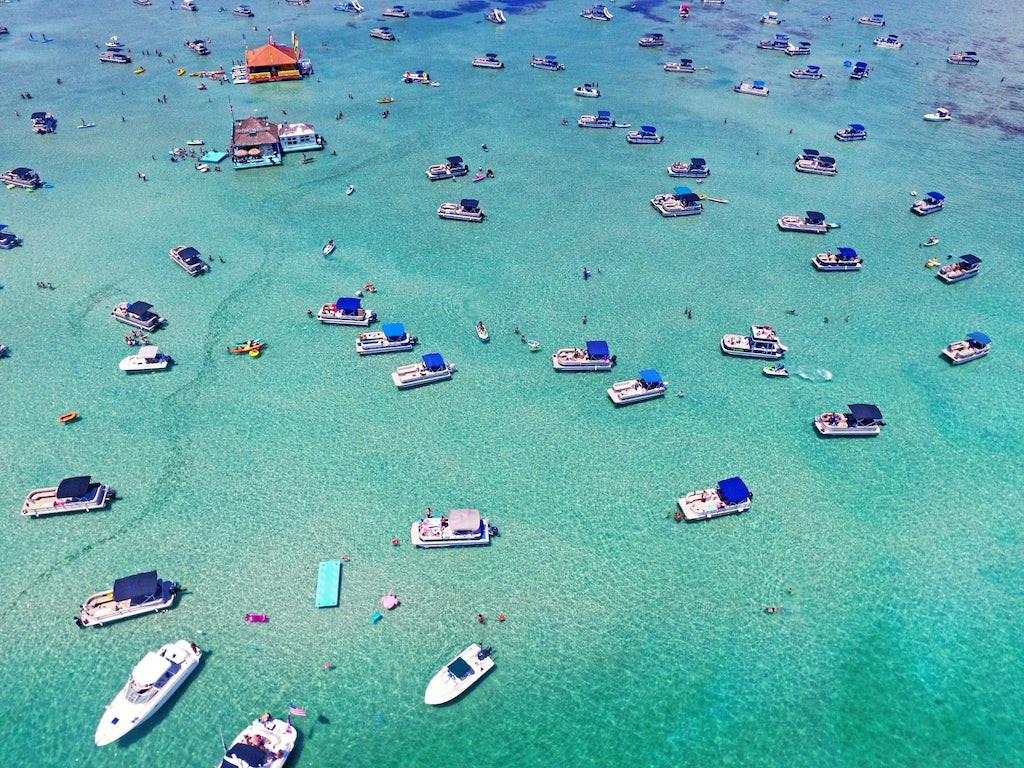
The Gulf of Mexico is often a beautiful emerald green in this region, which earned it the nickname of “The Emerald Coast”.
The clear water in Florida’s Panhandle Beaches has a slightly emerald green tint because of microscopic plankton in the water.
Microscopic plankton is a type of tiny plant. Like all plants, plankton contain green chlorophyll which is how they produce energy.
The green chlorophyll reflects light waves and gives Florida’s panhandle beaches their beautiful emerald green color.
Florida’s panhandle beaches also have clear water thanks to their unique variety of beach sand. Sand in Florida’s panhandle beaches is composed almost entirely of fine white quartz crystals.
Quartz is a natural mineral which is eroded from the Appalachian Mountains. The quartz flows into the Gulf of Mexico via the Apalachicola River.
Eventually the quartz sand is deposited on the seafloor and beaches from the Panhandle down into Florida’s central and southern Gulf of Mexico coast.
Quartz sand crystals are extremely fine and tend to fall to the seabed quickly. This allows the ocean water to remain extremely clear, especially in calm conditions without wind or wave disturbance.
Warning! Even in the Florida panhandle the ocean will appear murky during rough water conditions due to the suspended sediment in the water!
Popular beaches with clear water in the Florida Panhandle:
- Destin
- Panama City Beach
- Pensacola
- Crab Island Sandbar (Destin)
- Navarre Beach
- Rosemary Beach
- Grayton Beach
Gulf of Mexico Beaches
Florida’s Gulf of Mexico Beaches can have amazingly clear water, when conditions are perfectly calm.
Beaches near Tampa and St. Petersburg offer clear water, as do most of the beaches in southwest Florida.
North of the Tampa/St. Pete area the beaches become less “nice” as they approach Florida’s “Nature Coast”, which typically has fewer sand beaches and less clear water.
Beach sand in Florida’s central Gulf of Mexico beaches are a mixture of quartz and calcium carbonate, which is a byproduct of finely crushed seashells. This type of sand typically has large, coarse grains which tend to fall to the sea floor quickly.
Beaches with seashells tend to have clear water because the shells help keep sand from clouding the water and reducing visibility.
- Sarasota
- Boca Grande
- Beer Can Island (Longboat Key)
- Siesta Key
- Longboat Key
- Anna Maria Island
- Honeymoon island state park
- Caladesi island state park
- Anclote key preserve state park
- Egmont key
- Passage Key
- Sanibel island
- Captiva island
- Fort de soto
- Marco island
Clearwater
Many visitors assume that the beach destination of Clearwater was named after clear water in its beautiful beaches. But, it wasn’t!
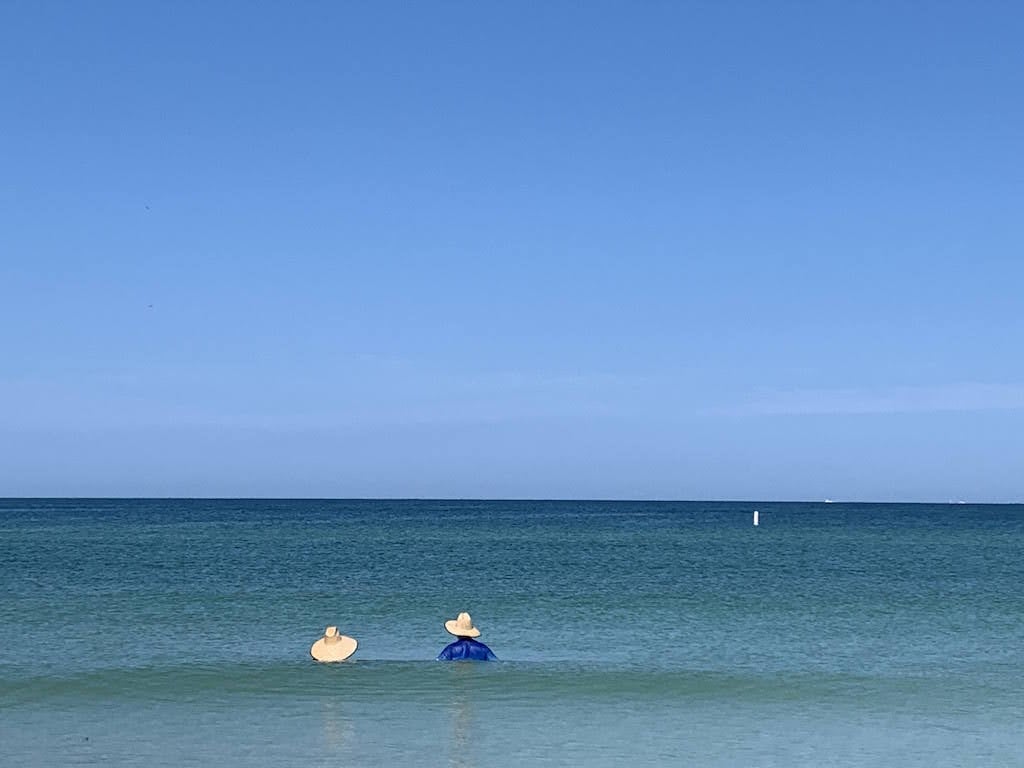
Clearwater actually got its name from a natural freshwater spring which was one of many located in the area of present-day Clearwater.
The natural spring was well-known and used by the Tocobaga Native American tribe.
The area of Clearwater came from a translation of a Native American word, “Pocotopaug”, which literally means “Clear water”.
The natural artesian spring flowed into the natural harbor. When early American settlers displaced the Native Americans they named the settlement “Clearwater Harbor”, which was eventually shortened to “Clearwater”.
The water in Clearwater can be clear when wind and wave conditions are very calm.
But, when wind and wave action is active the water is often murky and has a high amount of sand sediment in the water, which reduces visibility.
The Florida Keys
The Florida Keys are known for having extremely clear water.
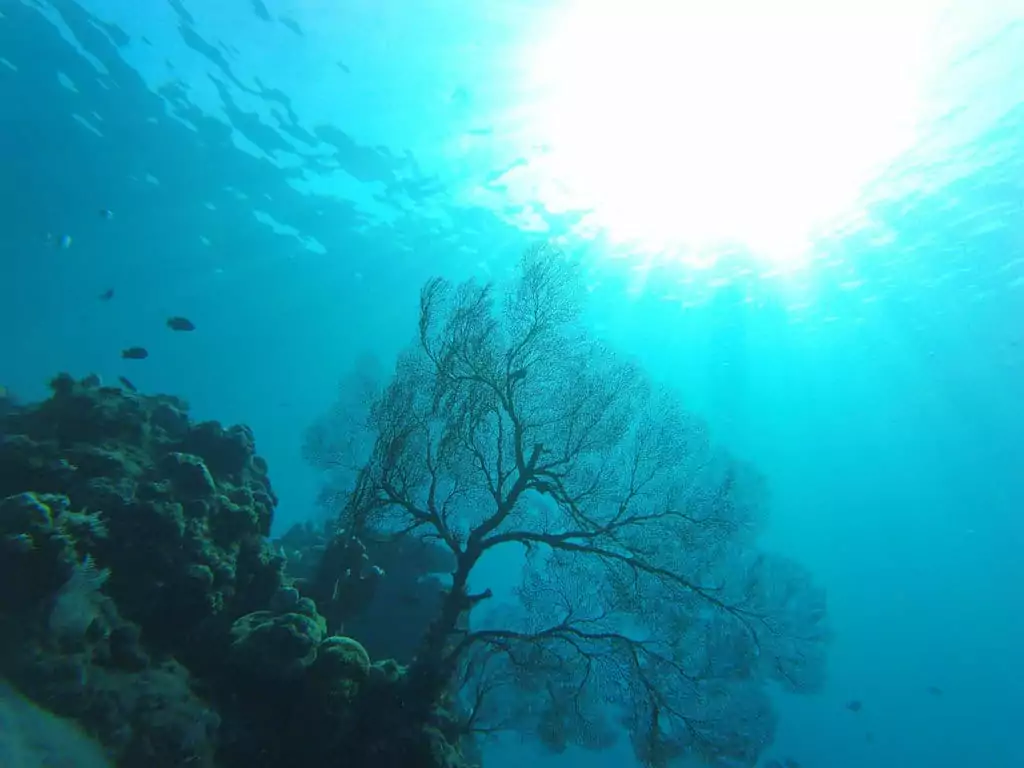
The clearest water in the Florida Keys is found offshore and away beaches.
Beaches in the Florida Keys tend to be small and do not have natural sandy shorelines.
Many shorelines of the Florida Keys have mangroves and silty beaches which are not accessible, and may have murky water when the water is disturbed.
Clean, clear water is usually found offshore, where sediment and sand are deep enough to avoid cloudy sedimentation.
Extremely clear water, with almost unlimited visibility, is usually found in deep water offshore, especially near the Florida Barrier Reef.
Clear water is also found in the Florida Keys Backcountry, west of the Keys. Backcountry waterways feature a high number of popular sandbars.
Places with the clearest water in the Florida Keys
- Dry Tortugas National Park
- Biscayne National Park
- Bahia honda state park
- Sandbars found throughout the Keys
Dry Tortugas National Park
Dry Tortugas National Park has beaches with the clearest water in Florida.
Thanks to its protected status and remote island location, water in the Dry Tortugas is exceptionally clean and clear.
Dry Tortugas National Park is located approximately 67 miles west of Key West.
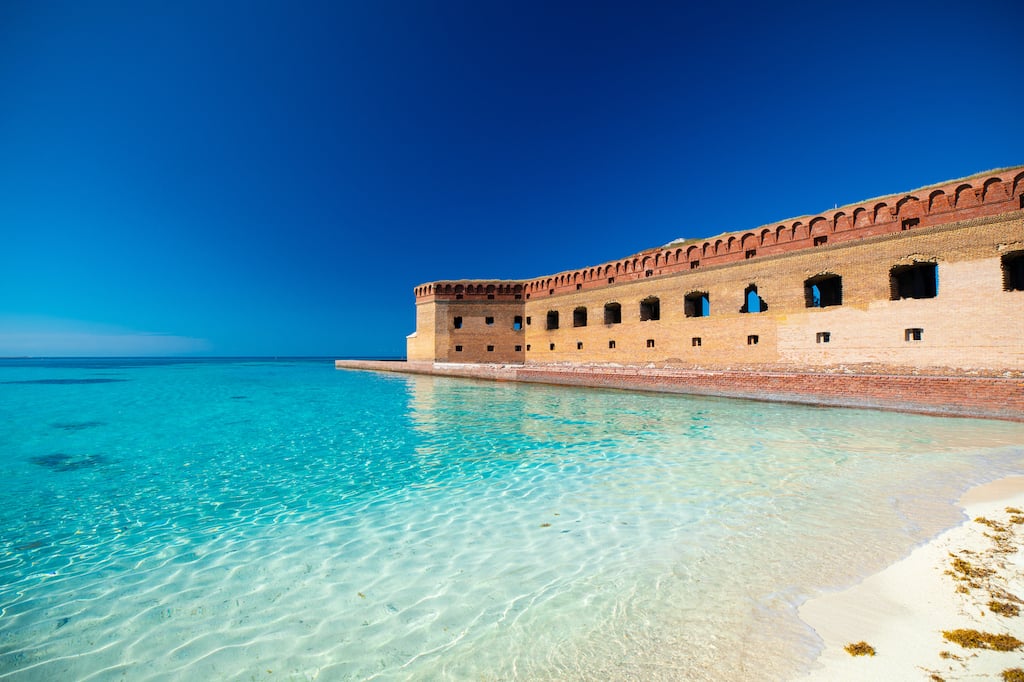
The remote islands are a bit difficult to reach, and the trip is expensive unless you visit by private boat. But, the Dry Tortugas have the clearest water in Florida, by far.
The remote location and deep surrounding water allows the water to be extremely clear and free from suspended debris in the water which might reduce visibility.
The protected waters are also filled with coral and countless marine organisms which thrive in the pristine, protected habitat.
The beaches are also the most beautiful in Florida, arguably.
Key West
The water clarity around Key West is naturally clear, but water quality is severely damaged by large cruise ships.
Among other things, the giant ships damage the shallow sea floor and stir up sand and sediment.
When cruise ships stopped coming in 2020 the water clarity and environmental health improved dramatically.
Locals were amazed by the clear water they saw, and it highlighted how much damage the big cruise ships cause.
Giant cruise ships are highly controversial among locals who dislike the environmental damage.
The citizens of Key West voted to outlaw large cruise ships and protect their waterways, but their vote was circumvented under questionable circumstances.
Sadly, the environmental damage continues.
Florida’s East Coast
In general, shorelines and beaches on Florida’s East (Atlantic) coast don’t have clear water.
The main reason is because the Atlantic Ocean typically has strong and steady wind and waves.
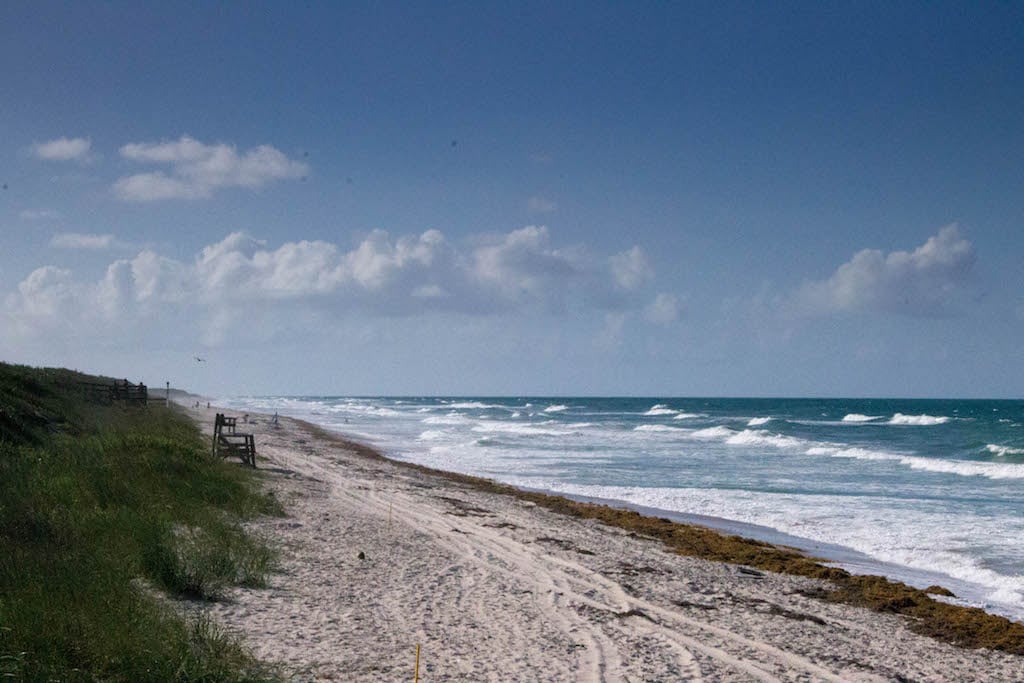
The waves “kick up” sand in the water. Disturbed sand reduces the visibility and leads to murky water conditions.
That said, beaches on the East Coast can have clear water during long periods of calm wind and wave conditions, if enough time is allowed for sediment to settle and fall to the sea floor.
Long periods of offshore winds (blowing away from the beach) can also produce high visibility conditions with clear water.
And, some areas on Florida’s East Coast do have clear water more often than others.
Beaches in south Florida tend to have clear water conditions more frequently than Florida’s central Atlantic coast or northern Atlantic coast, due to a number of geographical factors.
Most places with clear water on the east coast are located in protected waterways, and are protected from wave action.
Miami
The water in Miami’s beaches is naturally clear. But, it’s usually murky near the beach because of wave action and sand in the “surf zone” where strong waves break.
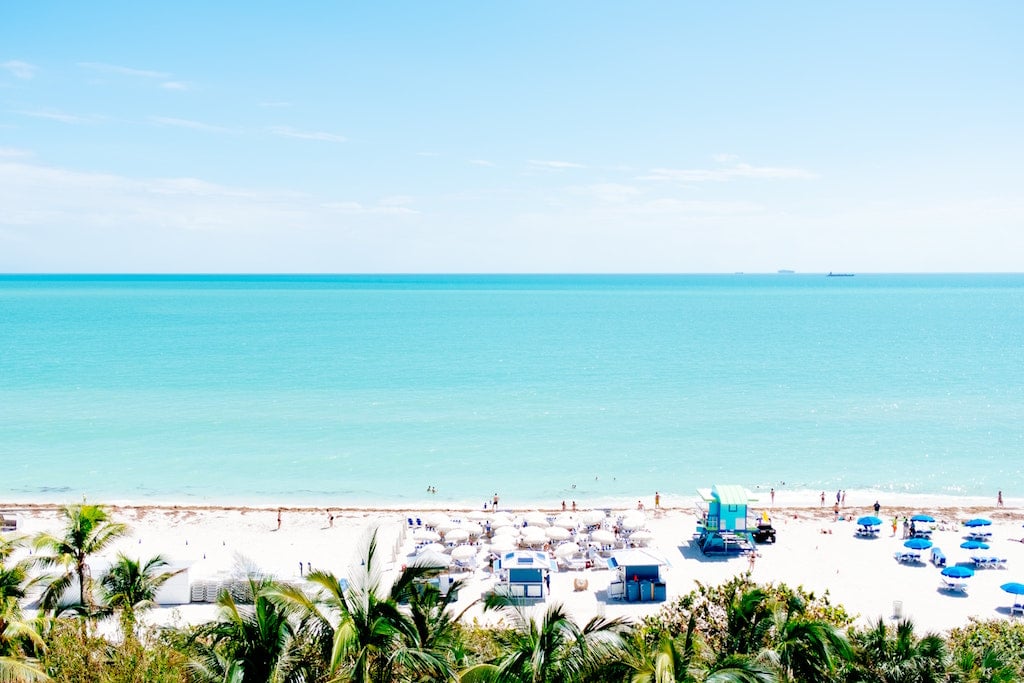
The water often becomes extremely clear just beyond the wave zone though, when coarse sand is allowed to settle onto the seabed beneath deep water.
During calm conditions without wind or waves, the water can be as clear as the water in the Bahamas.
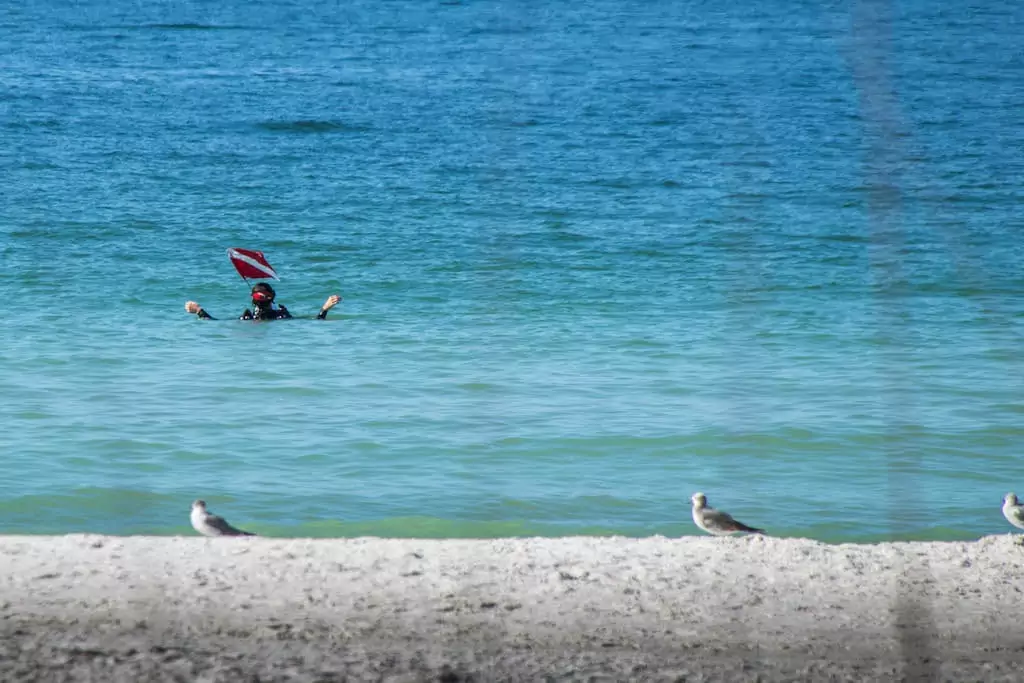
Miami’s sandbars and offshore areas have amazingly clear water, including the Nixon Sandbar and Haulover Sandbar, among others.
The sandy beach at nearby Oleta River State Park also offers clear water becuase it has calm and protected water, with very low wave action.
Southern regions of Miami in Key Biscayne and Key Biscayne National Park also have clear water, especially in deeper water.
Beaches in Miami, the Florida Keys and other areas of south Florida have sand which comes from finely eroded coral reef and quartz.
Peanut Island
Peanut Island Park is one of the best beaches in Florida. The small island has extremely clear water and beautiful white sand beaches.
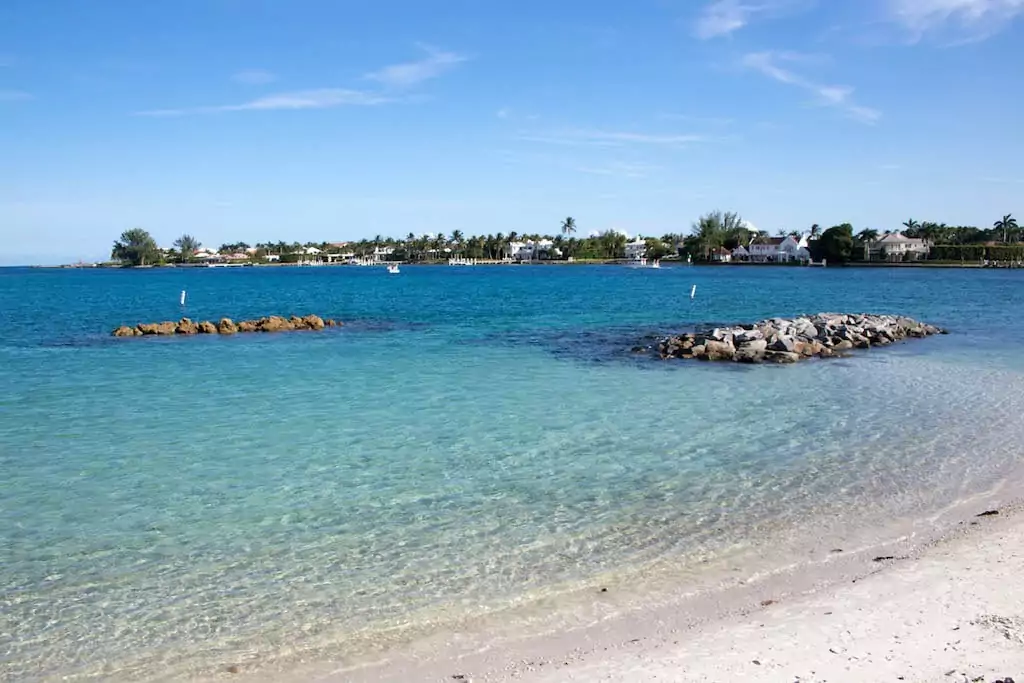
Peanut Island is located in the Palm Beach Inlet in the Lake Worth Lagoon. The inlet and lagoon are protected waterways with lower levels of wind and wave action.
The water around Peanut Island is extremely clear at high tide because clean water floods into the inlet from the Atlantic Ocean.
The water is slightly less clear during low and outgoing tides, when brown, murky water from the Lake Worth Lagoon flows out into the Atlantic Ocean.
Peanut Island is located just across the water from Phil Foster Park, which also has amazingly clear water during high tide and when conditions are favorable.
Phil Foster Park
Phil Foster Park is often named one of the best scuba diving sites in Florida.
SCUBA divers love the spot because of its convenient shore access, clear water and amazing array of wildlife. It’s especially known for “macro diving” and the chance to observe tiny, exotic marine life.
Like its neighbor Peanut Island, the waters off of the Blue Heron Bridge can be filled with amazingly clear water during high tide, or incoming tides.
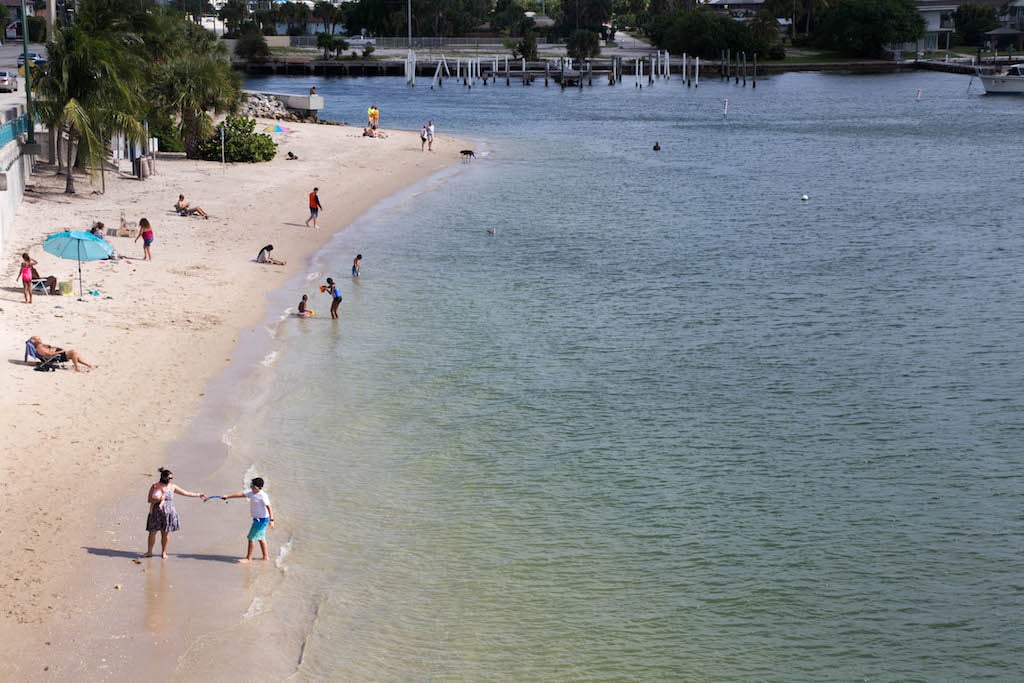
The water around Phil Foster Park is in a well-protected inlet, so it’s usually not wavy, choppy or rough.
The water does tend to be murky during outgoing tides and at low tide, though. Visitors should be sure to check the tide tables before visiting.
Fort Pierce
Beaches in Fort Pierce are typically not crystal clear due to wave action.
But, sandbars along the Fort Pierce Inlet, and inland waterways in the inlet, offer clean and clear water, especially at high tide.
Jupiter
Jupiter Florida has amazingly clear water, including offshore and inside the Jupiter Inlet.
During high tide clean, clear water from the Atlantic Ocean rushes into the Jupiter Inlet, the Loxahatchee River, Indian River, ICW and other waterways.
During the right tide conditions the water is crystal clear, and provides some of the best snorkeling in Florida.
The waterways are also home to several of the most popular sandbars in Florida, including the Tequesta Sandbar.
The Blue Lagoon in Jupiter
The Blue Lagoon in Jupiter offers some of the clearest water in Florida’s east coast!
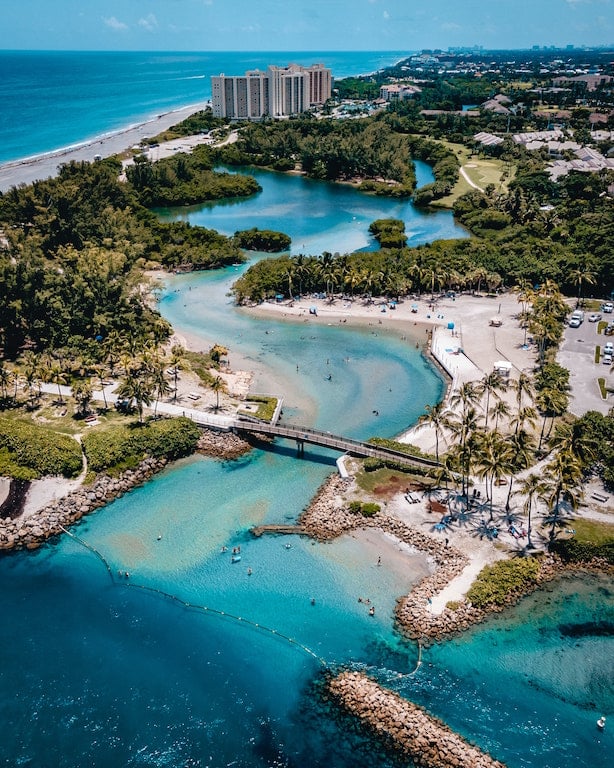
The lagoon is protected from ocean swell, but still benefits from clean, clear water which floods into the inlet from the Atlantic Ocean at high tide.
The water is clearest at high tide, or during rising tides. Some areas of the lagoon are more clear than others, and the clarity will vary depending on conditions.
The Intracoastal Waterway
Many people are surprised to learn that the intracoastal waterway, or the ICW, has amazingly clear water. But, it does, in certain locations!
The ICW is very location-dependent and is heavily influenced by tidal conditions which flood the waterways with clean, clear water, or murky brown water.
The Tequesta Bridge is one ICW site which can offer some of the clearest water in Florida.
- Cato’s Bridge
- Peanut Island
- Phil Foster Park
Sandbars
Sandbars are famous for having some of the clearest water in Florida. There are countless sandbars sprinkled around Florida’s coasts.
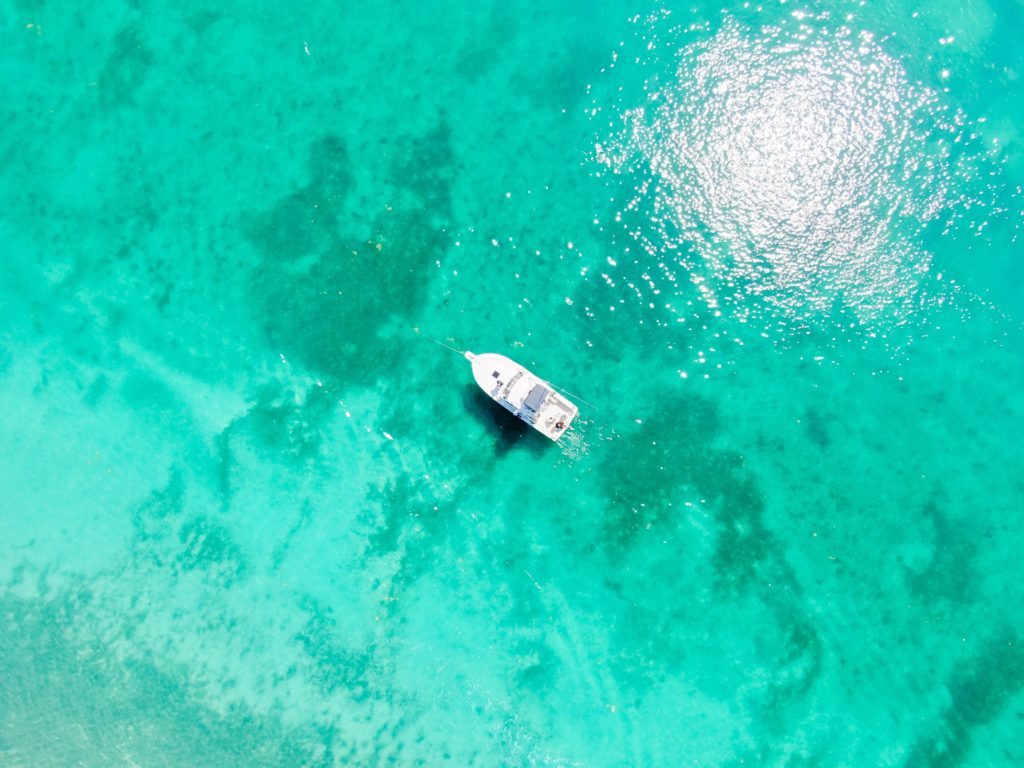
Almost all of the most popular sandbars have nice white sandy bottoms and clean, crystal-clear water.
The sandbars are usually located far enough away from shore that silt and sand sediment do not cloud the water, allowing the water column to remain clear and without muddy sediment.
On the downside, most sandbars in Florida require a boat or some sort of watercraft to access. Many sandbars can be reached only via private boat.
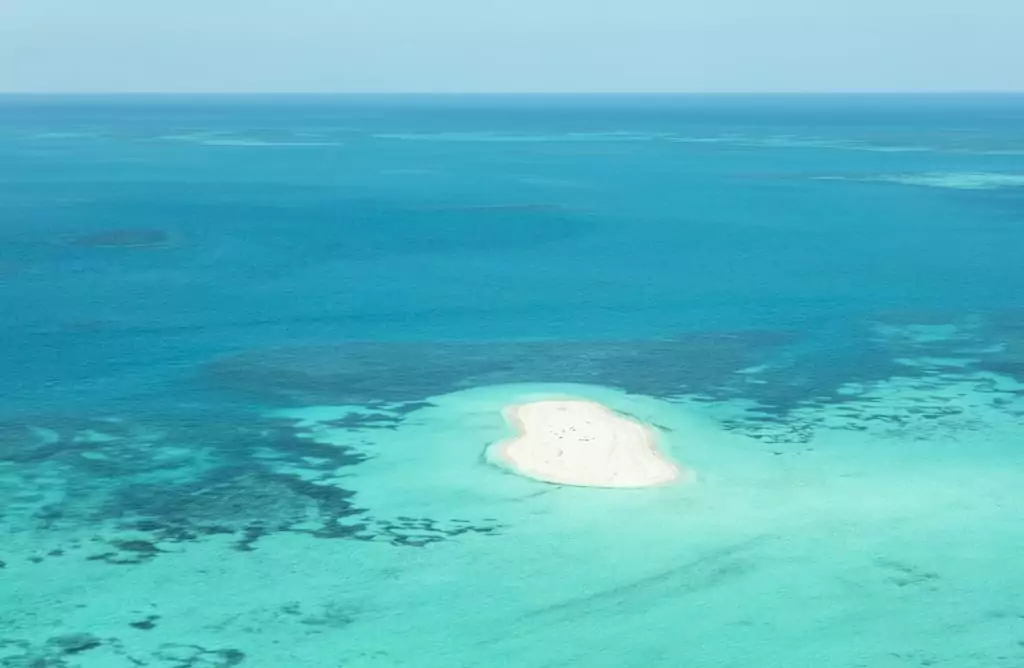
Some barrier islands can be reached via public ferry, including Peanut Island, Caladesi Island State Park and other pristine state park beaches.
The sandbars can also become crowded. Sadly, inexperienced boat operators often allow their propellers to disturb the sea floor.
Propeller damage causes serious damage to the marine environment, creates murky water and reduces water clarity.
Springs
Florida’s springs are world-famous for their crystal clear water.
Jacque Cousteau described Florida’s springs as “Visibility forever” because the water was so incredibly clear.
Some of the best springs in Florida for water clarity include Ginnie Springs, Ichetucknee Springs and many others.
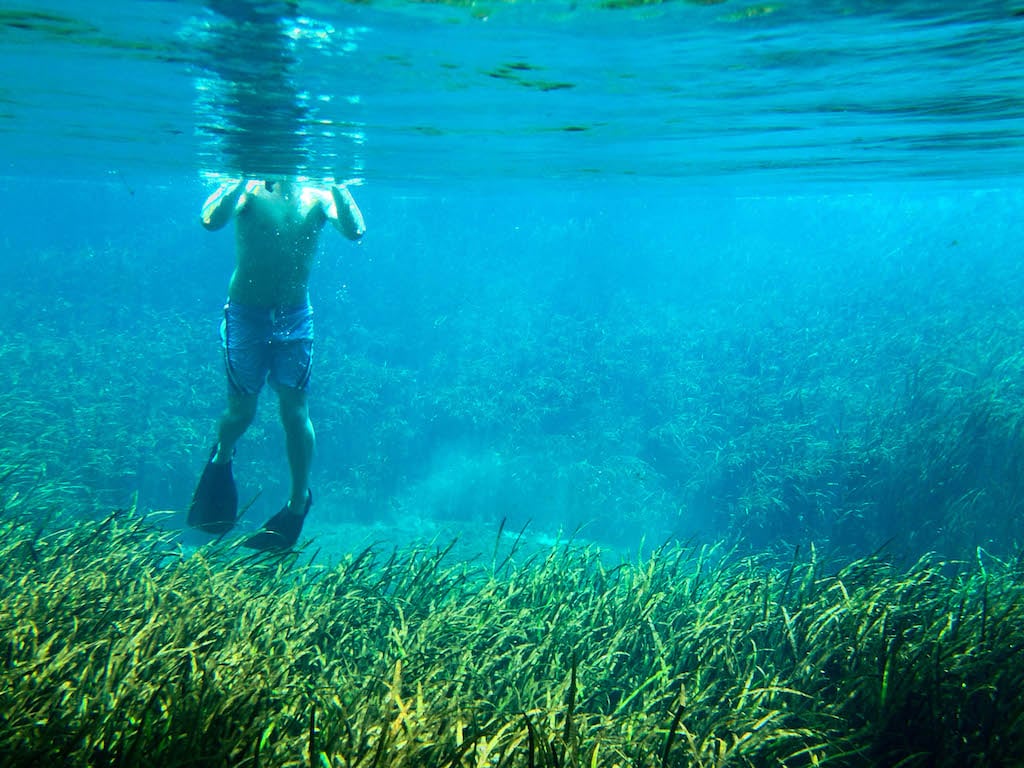
For example, the water in Ginnie Springs is crystal clear in spring basins and spring runs. The clear water then flows into the larger Santa Fe River, which is murky.
Many springs, including Warm Mineral Springs, do not have clear water due to high levels of algae and organic material in the water, among other factors.
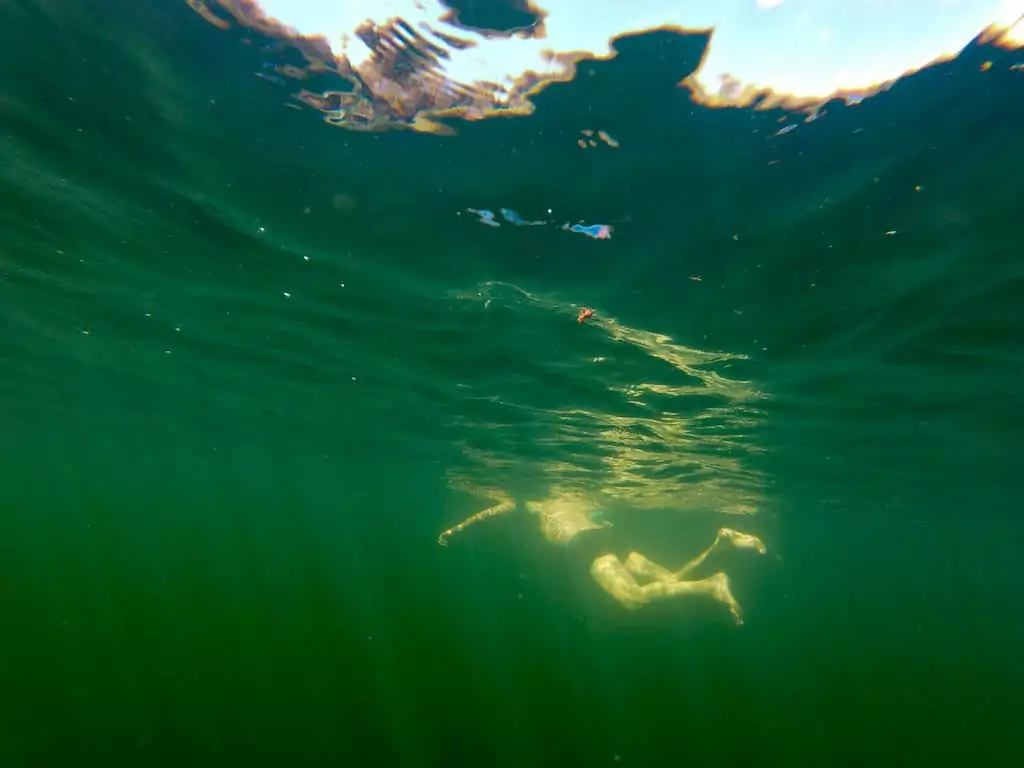
Many springs in Florida also suffer from water pollution and environmental damage which reduce their water clarity.
Sewage pollution, often from leaking septic tanks, is one of the biggest threats to Florida’s springs.
Sadly the clear water in Florida’s springs is also threatened by people’s feet which trample the fragile spring bottom.
Human feet, boats and other objects impact fragile spring bottoms and shorelines. Impacts cause serious erosion problems and spread sediment throughout the otherwise clean, clear water.
Large amounts of sediment in the water cause even more problems. Cloudy water from sediment kills off natural underwater grasses, which allows even more erosion, and a destructive cycle.
These springs have some of the clearest water in Florida:
- Rock Springs in Kelly Park
- Buford Springs
- Gilchrist Blue Springs
- Three Sisters Spring in Crystal River
- Devil’s Den Spring
- Blue Grotto
- Rainbow springs
- Blue springs state park
- Vortex Spring
- Morrison Spring
- Silver Glen Run
- Poe Springs
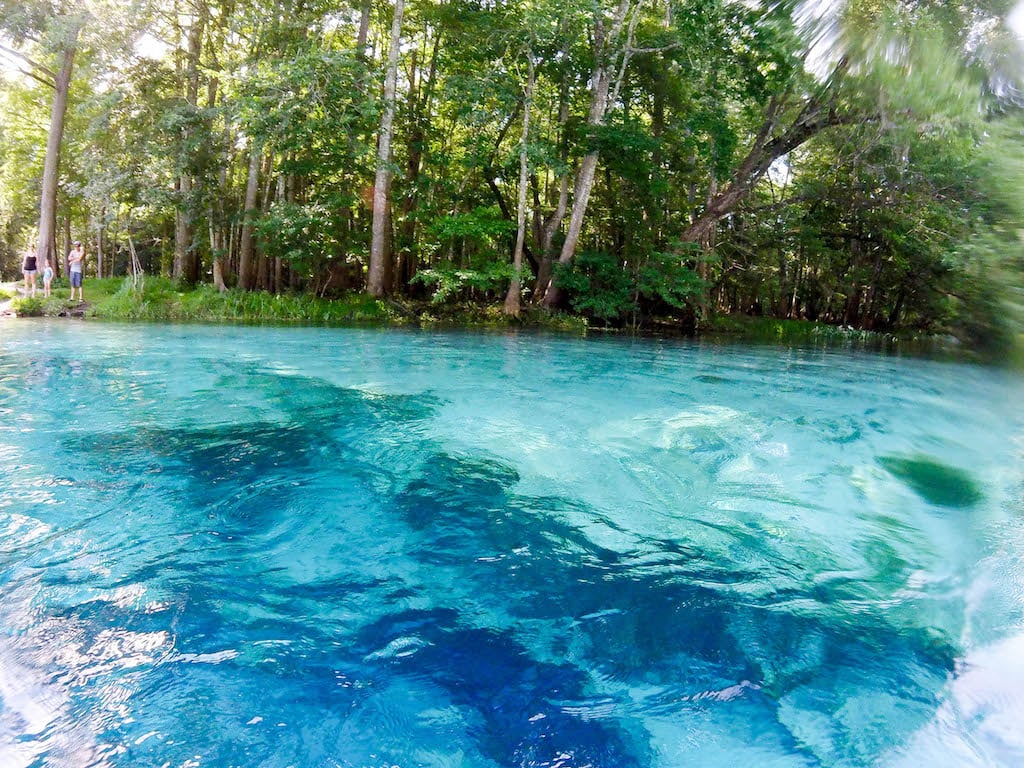
Rivers with Clear Water
Some rivers in Florida are dark and murky, and are not inviting to swim in. But, other rivers have amazingly clear water!
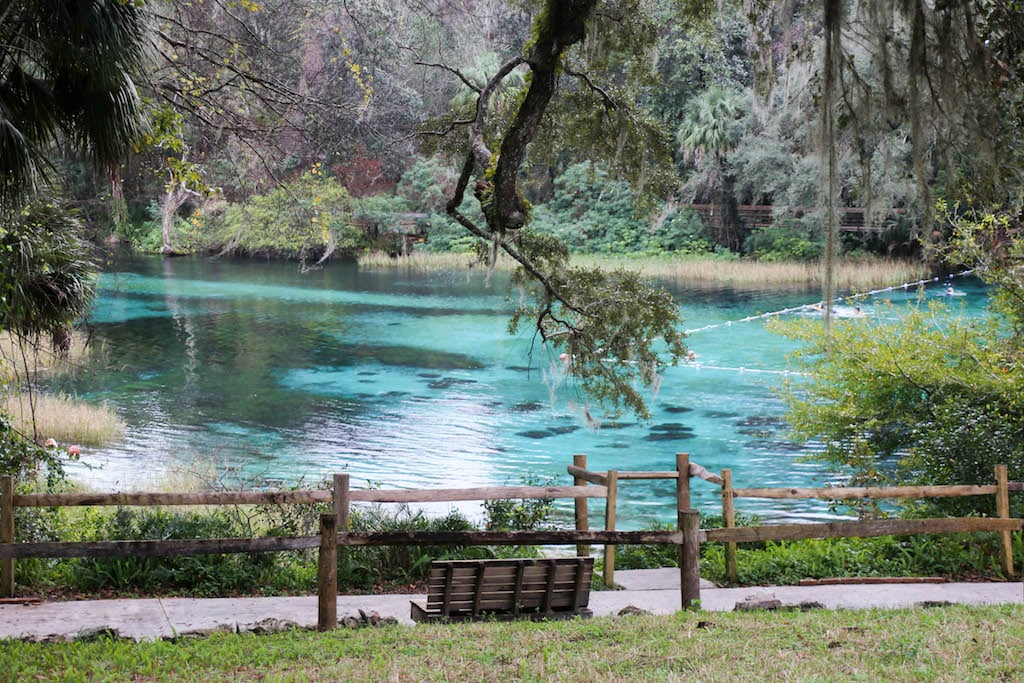
Most rivers with clear water are spring-fed, or are even spring runs. Rivers with clear water are usually smaller tributary rivers which empty into larger rivers, before flowing into a lake or ocean.
Rivers with the clearest water include:
- The Rainbow River
- The Ichetucknee River
- The Chassahowitzka River
- The Blackwater River
- Rock Springs Run
Beaches without clear water in Florida
Florida’s central and northern Atlantic beaches, stretching from Fort Lauderdale to St. Augustine, tend to have murkier water than other parts of the state.
Beaches on Florida’s east coast have more wave action which stirs up sand and sediment in the water.
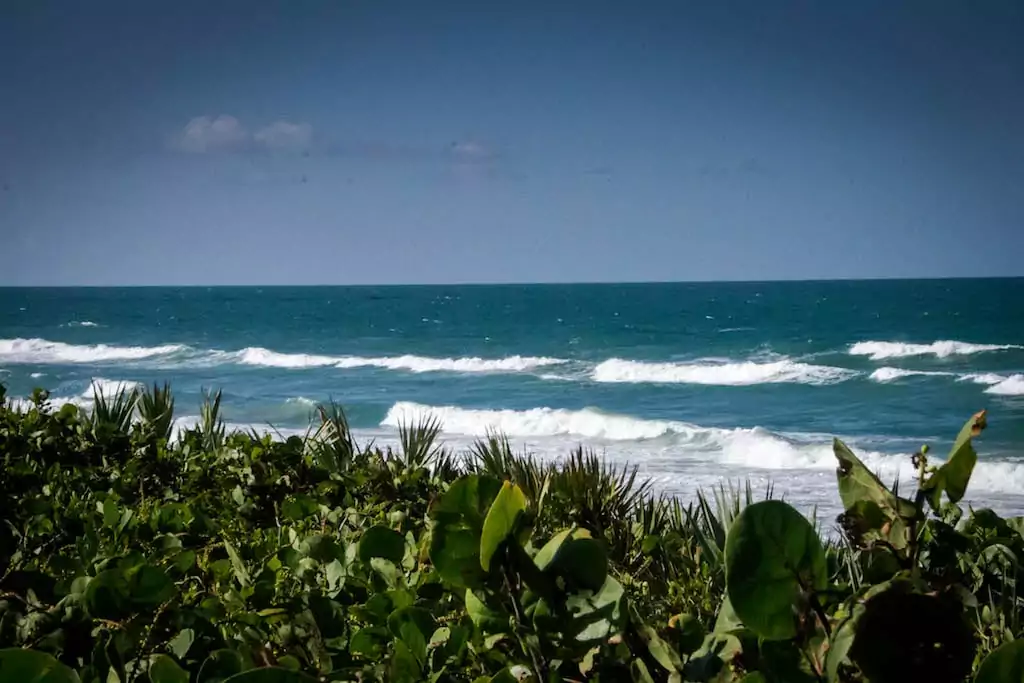
The constant wind and waves action from the Atlantic Ocean disturbs the sandy bottom and causes sediment to be suspended in the ocean waves, reducing water clarity.
Florida’s southern Atlantic Coast is partially shielded from wind and wave forces thanks to the Bahamas wind and wave shadow, which interrupt Atlantic Ocean wave energy before it reaches Florida.
Florida’s central and northern Atlantic beaches are not shielded by the Bahamas, so they tend to have more wave action. This makes for better surfing waves, but it also reduces the water clarity and generally makes the water rougher.
Other geographical factors also contribute to the reduced water clarity, like the location of the Gulf Stream, water depth and the location of the continental shelf.
Water clarity is often poorest after heavy rainfall, during strong winds, during choppy water conditions or when the sky is dark gray instead of deep blue.
Frequently Asked Questions
We’ve compiled a list of frequently asked questions about water clarity in Florida. If you have a question or if we left something out please let us know!
Where is the prettiest ocean water in Florida?
The prettiest ocean water in Florida is typically found in beaches in the Florida Panhandle, known as the “Emerald Coast”. Other “hidden gem” beaches with pretty water are found in other parts of Florida.
Where is turquoise water in Florida?
Turquoise water in Florida is found in many locations, including beaches in the Florida Panhandle, the central and southern Gulf of Mexico coast, the Florida Keys, and in selected beaches in southeast Florida.
Where is the pretty blue water in Florida?
Beautiful blue water is found in many places in Florida:
- Deep blue water is found in many places offshore of Florida’s shorelines in places where deep water allows sediment to fall to the bottom and there is no suspended sediment in the water column.
- Deep blue water is found in many of Florida’s springs, especially those where the water is deep.
- Clear blue water is found in many beaches and freshwater springs throughout Florida.
- Many bodies of water in Florida appear to be deep blue, especially during calm conditions then the water surface reflects a deep blue colored sky. Windy and choppy conditions often reduce the blue coloration.
What beach in Florida has the clearest water and white sand?
Florida beaches with the clearest water and whitest sand are found in the Florida Panhandle.
Clear blue water and white sand beaches are also found in islands, beaches and sandbars throughout other parts of Florida
Why is the water clear in Florida?
Florida’s water is extremely clear water because of several factors.
Mississippi River Delta Sediment
Florida is located to the east of the Mississippi River Delta, which discharges muddy sediment into the Gulf of Mexico.
The Mississippi River Delta is the reason why beaches in Texas and Louisiana usually have murky brown water, but Florida’s beaches have gin-clear water.
Interestingly the beaches in Alabama are on the border line and may have clear water, or murky brown water, depending on local conditions, especially the wind direction.
Sand Type
Many beaches in Florida have clear water because they have large, coarse grains of sand.
Coarse grains of sand tend to be heavier than lighter, finer sand grains, so they fall to the seafloor (and out of the water column) faster.
Islands, Sandbars and Geography
Many of Florida’s beaches are located on barrier islands and sandbars.
Barrier islands tend to have sand rather than topsoil or clay sediment, which contributes to clearer water.
Florida’s Aquifer
Florida’s springs are often crystal-clear bechase the water is filtered by the Florida Aquifer.
Inside the aquifer endless channels of porous limestone rock, and other natural filtration effects, clean the water and make it “gin-clear”.
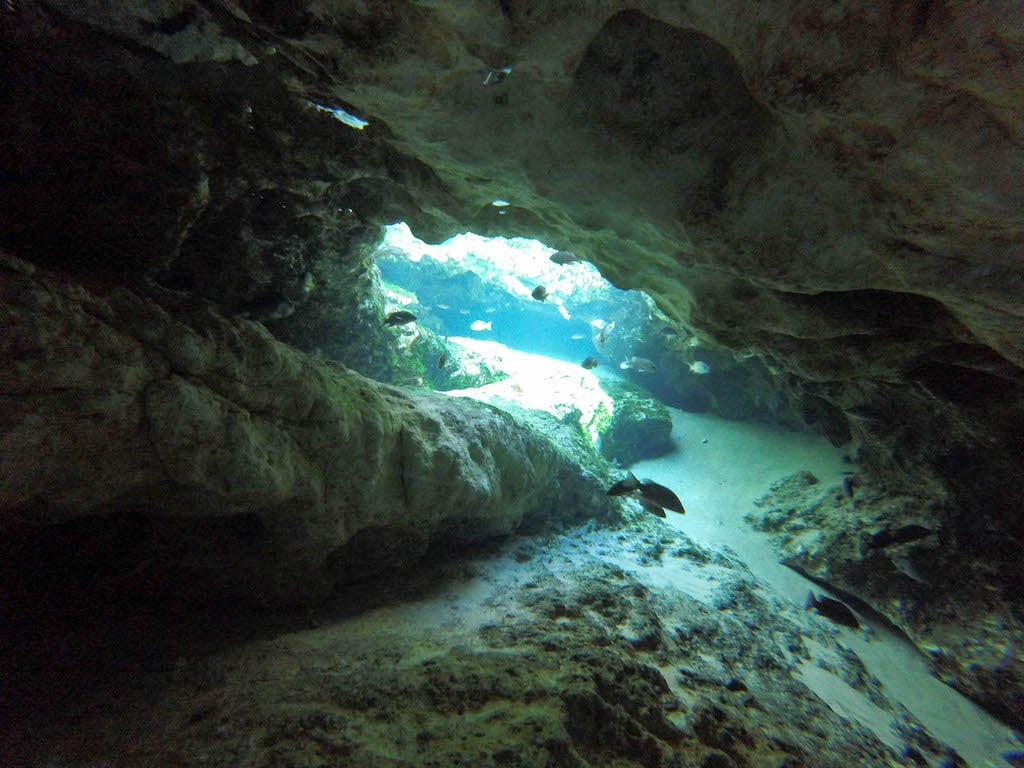
Many of Florida’s springs have sandy bottoms which also contribute to the water’s clarity and excellent visibility.
Conditions Needed for Clear Water
Water in Florida is often the most clear when:
- There is little to no wave action
- There is no freshwater river discharge or topsoil runoff
- The water is deep enough for sediment to fall to the ocean floor
- The sandy bottom has coarse, heavy sand
Bays, Wetlands and Estuaries
Many of Florida’s rivers drain into large bays, wetlands and estuaries. These natural features act as natural filters. They trap nutrients, topsoil, sediment, pollutants and other forms of groundwater runoff which would reduce water clarity.
One reason for the amazing water clarity in the Florida Keys is the presence of the Florida Everglades and Florida Bay.
Both natural features help contain sediment and filter polluted runoff which flows south from the Florida Everglades.
Seagrass
Seagrass is vitally important for protecting Florida’s clear water.
Seagrass helps prevent erosion and provides a natural trap for sediment and contaminants which would otherwise increase turbidity and reduce water clarity.
Sadly seagrass is under severe threat throughout Florida, which poses a severe threat to Florida’s water quality.
Algae and Plankton
Algae is bad for water clarity, and is often bad for water health.
High levels of suspended algae block sunlight, and kill seagrass.
Negative effects are especially bad during harmful algae outbreaks like red tide, blue-green algae, brown algae (sargassum) and other forms.
Water Quality
Sadly Florida’s natural environment is under severe threat, with far-reaching effects. The problem is only getting. Many problems, including algae, are caused by failing infrastructure and resulting problems, including human sewage pollution.
Even the clearest water can be polluted or contaminated with toxic algae, sewage or human fecal matter, or other pollutants.
It’s important to check the State of Florida’s water monitoring website for water quality information and potential beach closure information.
